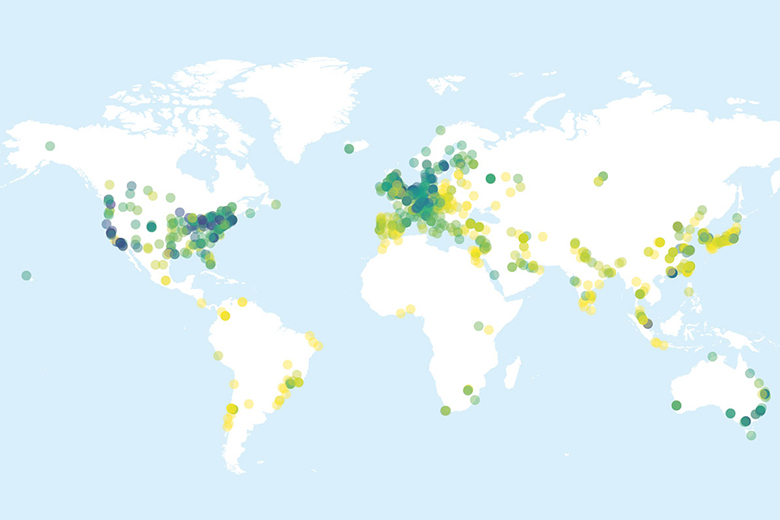Browse the full list of universities in this year’s rankings
The UK is home to the top two institutions in the Times Higher Education World University Rankings for the first time in the 14-year history of the table.
The University of Oxford has held on to the number one spot for the second year in a row, while the University of Cambridge has jumped from fourth to second place.
Cambridge’s rise comes at the expense of the California Institute of Technology, which was number one between 2012 and 2016, number two last year, and now shares third position with Stanford.
One reason for the movement is that Cambridge’s research income and research quality improved this year, while Caltech and Stanford were hurt by drops to their PhD-to-bachelor’s ratios. Caltech also received a much more modest rise in its research income per academic staff member compared with the other three institutions.
The US universities’ institutional income also dropped by 23 per cent and 24 per cent, respectively, while Cambridge and Oxford each received a boost in revenue (by 11 per cent and 24 per cent, respectively).
- The THE World University Rankings: now starring a cast of thousands
- Brian Schmidt – a laureate’s lesson in leadership
- Cornell’s commitment to its calling
- National University of Singapore: set for age of empowerment
Louise Richardson, Oxford’s vice-chancellor, said that she was “delighted that Oxford has held its position at the top of these global rankings”.
“To be judged the best university in the world for the second successive year, against a backdrop in which Britain’s role in the world is uncertain and the place of universities in society open to question, will be a great source of pride for everyone at Oxford, and, I hope, for the whole country,” said Professor Richardson.
“Success in our field is never an accident,” she added, stating that it is “achieved by a relentless pursuit of excellence, creative brilliance and a deep commitment to our enduring values”.
Sir Leszek Borysiewicz, Cambridge’s vice-chancellor, said that the result confirms that the university “is among a small group of the most respected higher education institutions globally”.
“We welcome the fact that UK institutions feature so highly in this year’s rankings, demonstrating their continued importance to the country and its economy,” Sir Leszek added.
- On the progress and prospects of THE’s rankings
- Asia and the network effect
- Universities must train a new breed of leaders
- Even the elite need improvement in some areas
Professor Richardson’s comments highlight the risk that Brexit may pose to the global position of the UK’s leading universities.
Almost a quarter of Cambridge’s research funding from competitive grants comes from the European Union, while the proportion at the University of Oxford is about a fifth.
Other institutions within the UK’s Russell Group, of whom 23 out of 24 feature in our top 200, with Queen’s University Belfast standing between 200 and 250, will also have concerns over the potential loss of EU research funding. Overall, 31 UK institutions feature in the top 200 and 93 are in the top 1,000.
This year, most Russell Group institutions held their position compared with last year’s standings – with a handful registering modest climbs or falls in our tables.
Sir Anton Muscatelli, vice-chancellor of the University of Glasgow (up to joint 80th from 88th in 2016), who is also chair of the Russell Group, said that the performance of the group’s members needed to be viewed in light of challenge posed by China and other Asia nations investing far higher percentages of GDP into higher education than the UK.
“Considering how fast other countries are improving their university systems it is fantastic to see so many Russell Group institutions feature in the top 100 and 200,” he said, adding, however, that the UK “cannot take its success for granted nor rest on its laurels”.
- Their dreams are not impossible
- The research and reputation nexus, a country comparison
- The key measures marking Asia’s progress
- Bear market: Russia is serious about internationalisation
The latest table suggests that the US and Australia’s standing in the table in future years could also be threatened.
Nearly all of the US’ top-200 representatives (59 out of 62) faced drops in their research income per academic staff member and future levels of federal research income under the Trump administration are in doubt. Two-fifths of the universities in this elite group (29) have dropped ranks.
Meanwhile, although Australia has maintained a relatively steady performance, its position in future years may suffer if the government goes ahead with plans to cut funding by 2.5 per cent, which would result in an A$2.8 billion (£1.7 billion) loss in income across the sector.
Both countries, as well as nations in Europe, face competition from rapidly rising institutions in Asia.
Peking University has risen two places to joint 27th, which puts it on a par with New York University and the University of Edinburgh and ahead of the Karolinska Institute.
Tsinghua University has climbed five places to 30th, overtaking the University of Melbourne, Georgia Institute of Technology, LMU Munich and École Polytechnique Fédérale de Lausanne.
Both those Chinese institutions have improved in terms of their reputations for teaching and research this year – meaning that there are now three Asian universities in the top 30 of the ranking for the first time under the current methodology.
Asia’s top university, the National University of Singapore, has risen two places to joint 22nd, meaning that it is level with the University of Toronto and now outranks Carnegie Mellon University. Its president, Tan Chorh-Chuan, said that he was “delighted by [this] strong endorsement of the global reputation, high quality and deep impact of NUS’ education and research”.
ellie.bothwell@timeshighereducation.com
THE World University Rankings 2018: top 10
| 2018 rank | 2017 rank | University | Country |
| 1 | 1 | University of Oxford | United Kingdom |
| 2 | 4 | University of Cambridge | United Kingdom |
| =3 | 2 | California Institute of Technology | United States |
| =3 | 3 | Stanford University | United States |
| 5 | 5 | Massachusetts Institute of Technology | United States |
| 6 | 6 | Harvard University | United States |
| 7 | 7 | Princeton University | United States |
| 8 | 8 | Imperial College London | United Kingdom |
| 9 | =10 | University of Chicago | United States |
| =10 | 9 | ETH Zurich – Swiss Federal Institute of Technology Zurich | Switzerland |
| =10 | 13 | University of Pennsylvania | United States |
Browse the full list of universities in this year’s rankings

Pressure makes diamonds
Intense global competition for talent and funds is driving changes among the traditional Western higher education powers – and even some institutions in Asia are feeling the heat
It is not easy to encapsulate the core elements that ensure that the world’s leading universities endure as centres of excellence, particularly amid growing global competition.
But the president of New York University points to three main characteristics that first drew him to head up the world-leading institution.
One is its urban nature.
“Fifty years ago, that might not have been an advantage. But today, as more and more of the world’s population flocks to cities, it is a huge advantage,” says Andrew Hamilton, who became NYU’s leader in January 2016 after serving at the helm of the University of Oxford for six years.
“Students and faculty like the vibrancy and diversity of cities. For faculty, it is the interesting opportunities for research, and the opportunity to weave the city into their teaching, and to live in a major, cosmopolitan city with its important cultural, intellectual, and education institutions.
“For the students, it’s the access to internships, the sense of connection between their education and their careers, and the sense that they are getting their adult lives started earlier than their peers.
“NYU has always touted its connection to New York, and as New York’s fortunes have soared, so have NYU’s.”
The second element is the institution’s global outlook. The university opened its first sites abroad – in Paris and Madrid – some six decades ago, says Hamilton, and it now has degree-granting research university campuses in Abu Dhabi and Shanghai.
But perhaps the most interesting attribute is the third: the university’s “audacity”.
“NYU is simply less hidebound than many of its peers, and is willing to make bolder moves,” he says.
- Pillars of excellence: the top 50 for teaching
- Pillars of excellence: the top 50 for research
- Pillars of excellence: the top 50 for industry income
- Pillars of excellence: the top 50 for internationalisation
“Coming from several universities that are reverential about their pasts, I was eager to be president of an institution that is more focused on its future, that is still very much in the process of inventing itself, and that is very ambitious.”
Given such drive and ambition, it is perhaps no surprise that NYU is the joint biggest riser in the top 30 of the Times Higher Education World University Rankings 2018, climbing five positions to reach joint 27th place. Its improvement in the table is largely thanks to advances it has made in terms of research output, research income and industry income relative to its staff numbers. Tsinghua also rose five places to enter the top 30.
As for NYU’s research growth, the key to that, according to Hamilton, is an initiative that was launched about a decade ago with the aim of increasing the number of tenured and tenure-track faculty in core arts and sciences disciplines by 20 per cent, with a particular focus on researchers at the forefront of their fields and junior scholars who showed “extraordinary promise”.
In the past few years, this has paid off with an increase in the university’s faculty per capita output, he says. Researchers are also now encouraged to form groups of collaborators to apply for multimillion-dollar grants, known as “mega-grants”.
Meanwhile, the merger of NYU with Polytechnic University in 2014 “restored engineering to NYU after 40 years’ absence”, Hamilton adds.
NYU’s growth in industry income, he says, reflects the overall expansion of industrial research in the surrounding city.
“New York City has very consciously sought to make itself a counterweight to Silicon Valley and other locations in terms of science and commercial technology. Our new building in Brooklyn [370 Jay Street will be home to departments in technology and the arts] is a result of that effort. Now New York has Google, Facebook, IBM Watson, and we have partnerships with all of them,” Hamilton explains.
NYU is not the only significant mover in the upper echelons of the ranking. The University of Cambridge has advanced to second, up from fourth last year. With the University of Oxford holding on to the number one spot for the second year in a row, this means that two UK universities lead the rankings for the first time in the 14 years we have been compiling them.
Cambridge’s rise comes at the expense of the California Institute of Technology (which was number one between 2012 and 2016 and number two last year), which now shares third position in the ranking with Stanford University.
The University of Pennsylvania is the only newcomer to the top 10, climbing three places to joint 10th, while the University of California, Berkeley has fallen out of this elite group, sliding eight places to 18th. The main driver of Berkeley’s decline is a large drop in its research income per academic.

Read the methodology underpinning the THE World University Rankings
There are some other notable swings in the top 50. The University of California, San Diego has climbed 10 spots to 31st, thanks to an increase in its scores for the three research metrics (reputation, income and output) and a rise in the amount of industry income it received per staff.
Meanwhile, a European heavyweight, the Karolinska Institute, has gone 10 places in the other direction (to joint 38th), largely as a result of a weaker score for its research and teaching reputations. This may be a result of the scandal surrounding visiting professor Paolo Macchiarini and the deaths of two of his patients at Karolinska University Hospital. An external inquiry into the institution’s handling of his case, which was published last September, said that the institute had a “nonchalant attitude towards regulations”.
When looking at national performance, the US and the UK appear stable in terms of the number of their representatives in the top 200 (62 and 31, respectively, compared with 63 and 32 last year), but several of their universities have lost ground.
Just over half of the UK universities (16) and two-fifths of the US institutions (29) have dropped places in the top 200.
It is a similar picture for some other major Western higher education nations.
Canada has just six top 200 representatives, two fewer than last year.
Germany is again the third most-represented country in this upper section, but two of its representatives have exited this group since last year. Of the 20 universities that still make this cohort, 12 have slipped.
There has also been some change among several Western countries’ flagships this year, with new faces leading the national teams.
In France, a joint 72nd place for Paris Sciences et Lettres – PSL Research University Paris means that it leads the country’s six top-200 representatives for the first time. PSL is a collegiate university – it was formed from 18 research institutions in the Paris area in 2010 and has been ranked as a single entity for the first time this year. It includes École Normale Supérieure, which was ranked 66th in last year’s table.
Italy and Spain also have new number ones: Scuola Superiore Sant’Anna and Pompeu Fabra University. Both universities climbed 35 places, reaching joint 155th and 140th, respectively.
Scuola Superiore Sant’Anna’s rise reflects the boost it has made to its research output and improvements in its research quality, while Pompeu Fabra has registered higher marks on all metrics related to teaching, research and citations.
The Spanish institution is also one of a handful of European universities outside the UK to feature in the top 50 when judged on citations alone.
Mapping excellence
This analysis shows clearly the distribution of universities by overall score in the rankings. Clusters in Europe, Australia and North America dominate the group of high-performing institutions
Ultimately, the results are a testament to the quality of the institution’s people, says Jaume Casals, rector of Pompeu Fabra. “Talent attracts more talent. It is a wheel that helps to improve our university’s scientific output results that, in turn, help to increase the global recognition.”
Casals adds that the university is looking to strengthen its internationalisation, to promote multidisciplinary learning and to update its governance and management in order to become a “dynamic and flexible institution that adapts easily to new times”.
However, he laments that Pompeu Fabra has a “far lower budget” than many of its global rivals and is “doomed to operate within the excessively rigid legal framework of the Spanish state, which generates an overly regulated ecosystem in the field of higher education”.
“What is more, it does not take into account important aspects of universities’ productivity when it comes to earmarking financial resources,” he continues.
“In short, we need more and better funding and fewer laws to be able to compete on equal terms in the global university league.”
Download a copy of the World University Rankings 2018 digital supplement
The Netherlands is another European country welcoming a new number one: the University of Amsterdam at 59th place (up from 63rd). The institution has seen an increase in its number of PhDs (relative to academic staff and bachelor’s degrees awarded), research income, publication output and citations since last year. It swaps places with former Dutch leader Delft University of Technology (63rd).
Frank Zuijdam, head of academic affairs at the University of Amsterdam, says that Dutch universities in general pay close attention to publication output and citations, but his institution places particular emphasis on prestigious research grants.
The university also has 20 research priority areas to encourage interdisciplinarity and to support fields in which the institution is “world-leading”, he says.
However, there are some potential threats to the country’s leading university system, Zuijdam adds.
One is that a high influx of students means that more state funding has to be allocated to education, which comes at the expense of research. The result is more competitive pressure on researchers to win funding. “You see that success rates are dropping at the research council because there are too many applications for the budget. The same is true for the European Union,” he says.
Another concern for Zuijdam is the large proportion of available research funding that tends to be steered towards applied research as opposed to blue-skies research.
Finally, higher education in the Netherlands faces “huge competition” from universities in other countries, particularly those in Asia, he adds.
“For countries such as the Netherlands, it is hard to compete with the kind of money they have,” he says. “For example, Singapore has built the nicest facilities, it hires the best researchers and gives them a lot of research money. As a country, we are very small and we have a different budget situation from some other universities in other countries.”
Browse Times Higher Education’s university rankings portfolio
Indeed, the continuing rise of Asia is one of the main themes of this year’s ranking.
The continent’s leading institution, the National University of Singapore, claims its highest position ever, joint 22nd place (up from 24th).
Peking University has risen two places to joint 27th while Tsinghua University moved up five to 30th.
And this is the first time that three Asian universities have claimed a spot in the top 30 of the ranking since 2010‑11.
Meanwhile, mainland China is now the joint sixth most-represented nation in the top 200. It has seven universities in this elite group, three more than last year, overtaking Hong Kong (with five top 200 institutions) as Asia’s most successful territory at the top of the ranking.
But the picture is not rosy for all Asian nations. While South Korea still has four institutions among the top 200, three of these have moved downward. And only one of its universities in the group of institutions ranked 201-1,000 has improved its performance.
Taiwan has suffered as well. The nation is only just clinging on to its top 200 spot after its flagship institution, National Taiwan University, fell three places to joint 198th. Its second-highest performer, National Tsing Hua University, has fallen from the 251-300 band to the 301-350 cohort.
Meanwhile, Japan’s top institution, the University of Tokyo, has dropped from 39th to 46th place, although both Kyoto University (joint 74th) and Osaka University (201-250) managed to move themselves upward.
The Chinese University of Hong Kong is one of Asia’s biggest risers this year, jumping 18 places to 58th, thanks in large part to a large boost in its reputation for research and teaching and improvements in its scores for citations and industry income.
Its vice-chancellor, Joseph Sung, says that CUHK’s greater research quality and influence is down to institutional efforts in “recruiting top academic staff, developing research of international impact, developing international collaborations, solving large-scale societal problems, and participating in national projects in China”.
At the same time, new partnerships with businesses in mainland China, Hong Kong and other countries have helped to boost its industry income, he says.
“Four new joint laboratories have been formed with international and Chinese partners since January 2016. Currently, CUHK has 62 joint research establishments,” Sung says.
But even CUHK is feeling the pressure from its regional rivals.
“Around the world, governments in many countries have invested strategically to advance the research capability and output, as well as the ranking and reputation of their universities. These include China, Japan, South Korea, Singapore and other Asean [Association of Southeast Asian Nations] countries,” he says.
“CUHK therefore has to respond to this fierce competition and distinguish itself in the fast-changing world by enhancing its reputation, presence, relevance and impact globally.”
Money matters
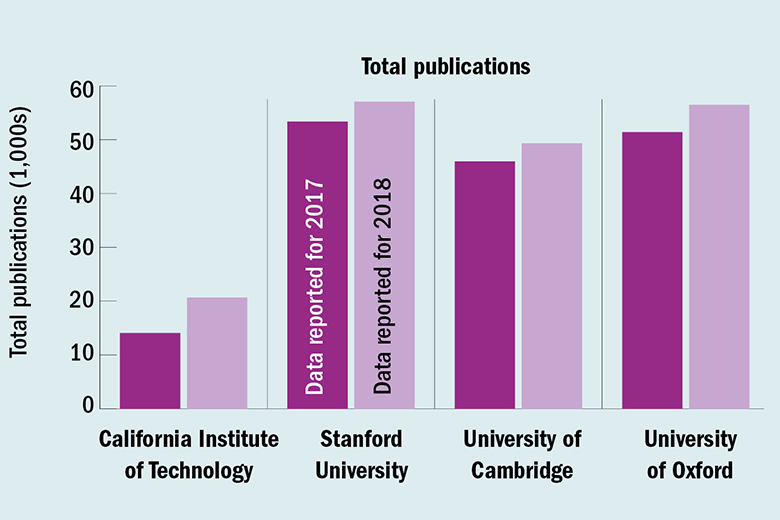
The University of Cambridge’s rise to second place is one of the most notable changes in the table since last year.
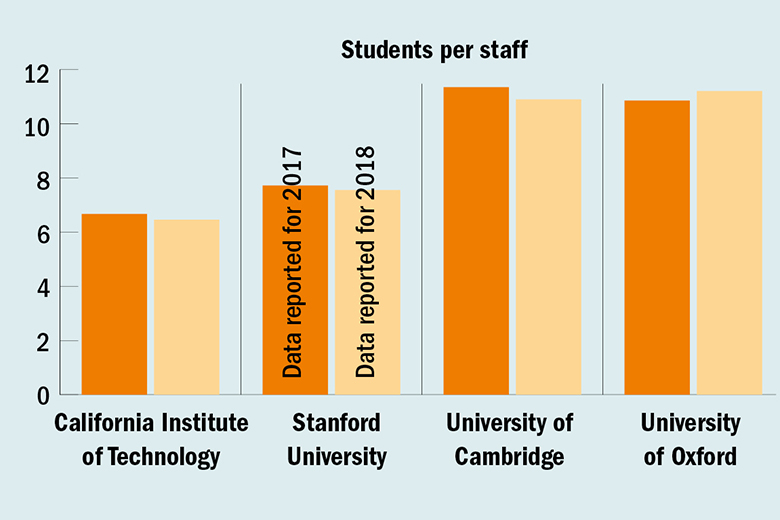
One reason for the movement is that Cambridge’s research income and research quality improved this year, while the California Institute of Technology and Stanford University (which share third place) were hurt by drops in their PhD-to-bachelor’s ratio.
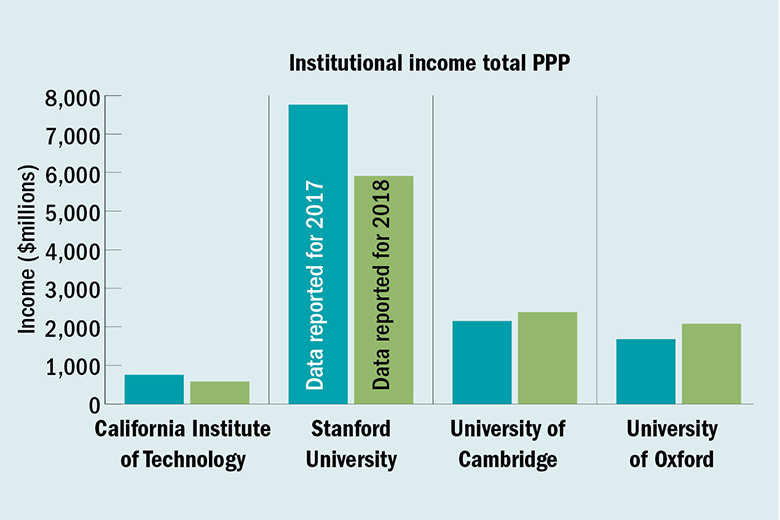
The above graph also shows that the US universities’ institutional income dropped by 23 per cent and 24 per cent, respectively, while Cambridge and the University of Oxford each received a boost in revenue (by 11 per cent and 24 per cent, respectively).
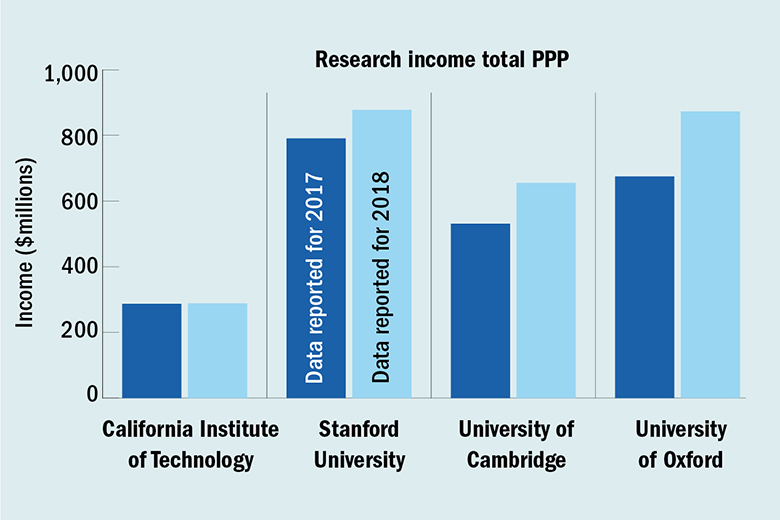
Caltech also achieved a much more modest rise in its research income per academic staff compared with the other three institutions, which is another reason why it dropped from second to joint third place.
Multitalented: success in all areas
None of the 1,000 universities ranked in this year’s table is outstanding across all five “pillars” underlying the methodology – not one of them makes the top 50 in teaching, research, citations, industry income and international outlook.
But analysis of the results reveals an elite group of seven universities that excel in four core areas.
Four UK institutions – the University of Oxford, the University of Cambridge, Imperial College London and the University of Edinburgh – make the top 50 for teaching, research, citations and internationalisation, but trail the leaders when it comes to industry income, reflecting the UK’s poor performance in this metric.
Imperial achieves the UK’s top score for knowledge transfer, but it is still 119th in the world on this measure.
Another three US institutions – Duke University, the University of California, San Diego and Johns Hopkins University – are world-leading for their teaching, research, citations and industry income, but they lose their edge when it comes to their international outlook. The top-ranked US university for internationalisation is the Massachusetts Institute of Technology, ranking 81st in this pillar.
The US’ large size, which means that it has its own large talent pool of scholars and students, may be one factor in this.
Pradeep Khosla, the chancellor of UC San Diego, attributes the institution’s broad strength to “being unbound by tradition” and having the “liberty to innovate”.
“UC San Diego was an experiment: our model from day one was focused on issues and the greater good, rather than disciplines,” he says.
“This non-traditional approach allows our students, faculty and researchers to make contributions that benefit society, and our collaborative environment among top scholars propels strengths in disciplines across the board.”
The university’s location on the Torrey Pines Mesa, which is home to many major biomedical institutes, is another factor explaining why the university performs so well in terms of industry income and has jumped 90 places to 37th in the pillar this year.
Register to continue
Why register?
- Registration is free and only takes a moment
- Once registered, you can read 3 articles a month
- Sign up for our newsletter
Subscribe
Or subscribe for unlimited access to:
- Unlimited access to news, views, insights & reviews
- Digital editions
- Digital access to THE’s university and college rankings analysis
Already registered or a current subscriber?

